The Black presence in European history at the National Gallery of Denmark
Gemma Romain
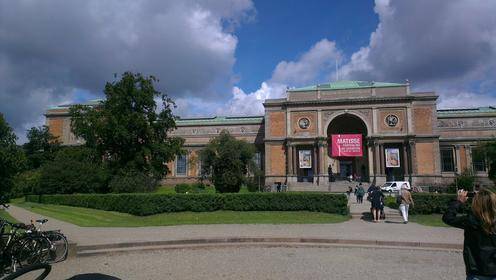
Visual culture of the early modern period not only reveals much about the presence of Black people in Europe, but also informs us of some of the ways in which this presence was viewed, interpreted and imagined by European societies. Exhibitions and publications including the multi-volume Harvard University Press/WEB Du Bois Institute's Image of the Black in Western Art edited by David Bindman and Henry Louis Gates Jr, Temi Odumosu's website resource Image of Black, and Esther Schreuder's recent Black is Beautiful exhibition in Holland have served to highlight the manifest number of artworks in existence representing the Black presence throughout medieval, early modern and modern Europe.
On a recent trip to Denmark, I visited several museums and galleries including the National Museum of Denmark, the National Gallery of Denmark, the NY Carlsberg Glyptotek, and Christiansborg Palace. I was particularly interested in exploring how the Black presence would be represented within these various institutions, and whether Denmark's history of imperialism and colonialism would be acknowledged and contextualised within the narrative of Danish history presented to the public. Although the involvement was not as large as European countries including Britain, France, Holland, and Portugal, Denmark had significant involvement with imperial expansion, colonialism and slavery in Africa and the Americas.
Visiting the National Gallery of Denmark was a richly rewarding experience; it includes a range of incredible pieces of artwork spanning 700 years of Northern European history. The gallery is divided into four permanent displays entitled European Art 1300-1800, Danish and Nordic Art 1750-1900, French Art 1900-30 and Danish and International Art after 1900. These four displays are sub-divided into several rooms, each thematic and divided into different regions/nations of Europe. Temporary exhibitions rotate throughout the year and the display I visited Matisse - Doubles and Variations, focused on Matisse and his process of repeating artworks.
Within these permanent galleries I found several significant and highly revealing pieces in the collections highlighting Black history in the context of European visual culture. They relate to both religious history and mythology and also European colonialism and imperial expansion - these pieces range in style from individual portraits, conversation pieces, and group representations. I spent most of my time in the first display European Art 1300-1800 and also explored the online catalogue, looking at images and details of pieces not currently exhibited. As well as investigating the pieces of art which were on display, I was interested in their context and in how they were displayed, as well as the historical narrative within the panel text surrounding them. I'll briefly describe here a few of these pieces, which mostly represent Dutch early modern history.
Each room contains an introductory explanatory panel and within most of the rooms there are directly relevant pieces to Black history, though more of these pieces can be found in the room exploring expansion and empire entitled New Worlds. New Wealth. The artworks within this room have extra contextual information relating to black history and western Europe. Several, though not the majority, of the pieces of artwork or groups of artwork have further text accompanying them providing, specific detail relating to the piece of artwork or the artist.
The first main room in European Art 1300-1800 entitled "The Good Man" explores the development of art from the years 1400 to 1600. As stated in the panel introduction, it explores how between 1400 and 1600 art was used primarily as a vehicle to "communicate religious and moral messages" and often centred upon the image and life story of Christ. These pieces of art could sit alone but were also often originally parts of panels, and were "privately owned altarpieces that gave their owners exclusive access to the religious realm within the comfort of their own home." Within this section there was a piece representing a common motif in early European religious art, that of the 'Black magus' in representations of the Adoration of the Magi; here we have an example from Hugo van der Goes's værksted entitled Adoration of the Kings. The gallery's online catalogue states this artwork was by an unknown artist, dated approximately 1500 and was probably a copy or partial copy after van der Goes. Bernhard Ridderbos describes Van der Goes as a significant fifteenth century artist, who was a member of the painters guild in Ghent and was to become a lay brother in a monastery nearby Brussels. Along with this piece, van der Goes represented other black people in religious artwork, including an Adoration altarpiece which is now located in the Hermitage in St. Petersburg (Allison Blakely: 84).
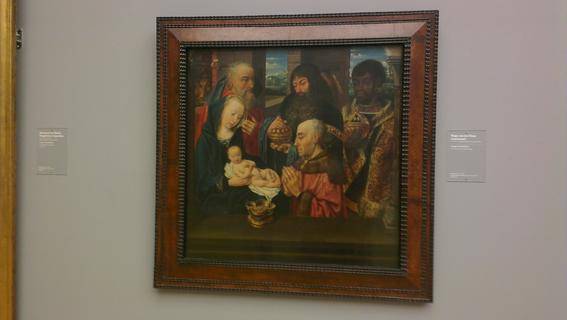
Allison Blakely states that "the Adoration of the Magi, featured in thousands of works, was the single most popular religious theme featuring blacks in sixteenth and seventeenth-century European art." Adoration artwork depicts an expanded version of the biblical story in the gospel of Matthew of Magi guided to bring gifts to the newborn Christ - as Joseph Leo Koerner describes, this brief narrative is then developed and expanded upon over the centuries and within different historical and social contexts to include names of the magi, their number being three (to correlate with the three gifts), that they were Kings, that they arrived in a procession from oldest to youngest, and eventually during the fifteenth century the youngest was commonly pictured as being black. The Black figure was based upon earlier European representations and mythologies of Black people and was used as a device or allegory representing the widespread nature of the conversion to Christ.
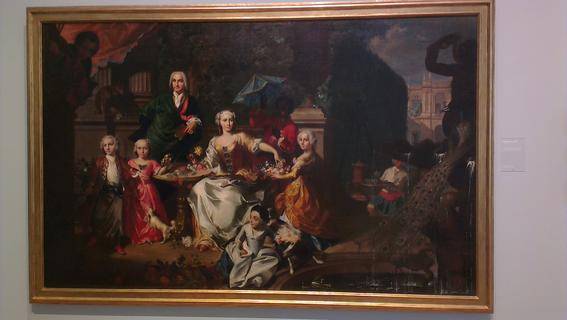
I came across this next piece in the section of the display focusing on early modern European art, generally representing likenesses of living people and portraits of the wealthy wishing to represent their actual or desired lifestyles. It is an oil on canvas, dated from 1737 by the German artist Marcus Tuscher. Tuscher lived and worked in cities in Italy, as well as London and Copenhagen. On the gallery's online catalogue the title of the artwork is given as "A Family Group on a Terrace in the Grounds of a Villa. Possibly the English Businessman George Jackson and his Family." This artwork depicts a common image in European visual history of a group, usually a family, including a black servant. Reflecting on the catalogue, it would be useful to include within the metadata of the artwork or in the index terms something to indicate a black servant is included in the piece. As is often the case in artwork of this type, no indication is given in the artwork title that a black person is included in the depiction and unless you came across the artwork in the gallery in person, it would be hard for a researcher wanting to explore black history in the collections to arrive at this piece.
Portraits of families with black servants were increasingly common in early modern Europe and served symbolically either to represent families with imperial, slave-owning links who often had black servants within the household, or to represent families who desired to be seen as possessing imperial links. The Black servant here is dressed in a common decorative, exoticised style and is holding a parasol. The common pose of the black servant holding a parasol traversed nations; Allison Blakely has found this a common pose in Dutch art.
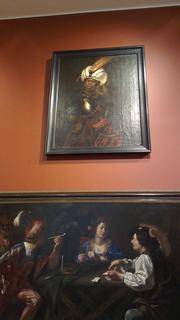
Another common early modern art motif also appearing within the gallery holdings is the representation of African men and boys in turbans, which can be seen in Dutch seventeenth century artist Karel van Mander's oil on canvas 'A Moor wearing a Turban and Armour' within the room exploring seventeenth century Holland entitled 'Rembrandt and His Time'. Rembrandt famously painted several black individuals within his artwork, including turbaned Africans. Africans in artwork were often portrayed in turbans, and were termed Moor as interchangeable with African. Beth Fowkes Tobin when referring to British early modern pieces, states 'several eighteenth-century portraits and conversation pieces contain the figure of the black servant. Most frequently a boy or an adolescent male, the servant is dressed in livery and wears either a turban or a skullcap. Both head coverings are exotic and allude to the Turkish, Moslem, and Mughal cultures of the Levant, northern Africa, and the Indian subcontinent.' (Tobin: 27) This type of portrayal could either be in conversational pieces and group family poses or in individual portraits of Africans, as in this case. Other pieces by Van Mander included in the gallery's collections is the painting Head of an African, 1624-1670.
These next pieces show an Emissary from Congo and his two servants, providing a significant visual representation of histories of colonialism and imperial expansion. They are three pieces attributed within the panel text to Dutch artist Jaspar Beckx (though possibly by the artist Albert Eckhout) and are entitled: 'A Servant of Don Miguel de Castro Carrying a Decorative Case'; 'A Servant of Don Miguel de Castro Carrying an Elephant's Tusk', and 'Don Miguel de Castro, Emissary of Congo' - these are intriguing pieces of artwork and I'd like to know more about their history and the figures within them. They are found in the section representing European expansion and empire '1600-1700 - The Netherlands: New Worlds. New Wealth' which also includes the artwork by Dirk Valkenburg entitled "Slave Play" on a Sugar Plantation in Surinam (1706-08).
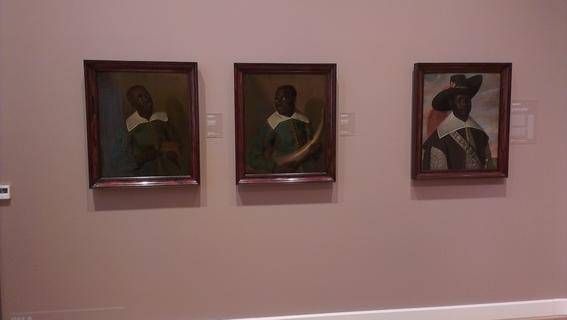
The panel text next to the artworks states "in 1643 or 1644 they arrived as part of a delegation sent by the ruler of Sonhe, a province of Congo, via Brazil to The Netherlands. One objective of the journey was to find a resolution to an internal conflict in Congo. The three portraits may have been painted in Brazil by Albert Eckhout, who did a number of paintings of Brazil scenes for the Dutch governor Johann Moritz of Nassau." I will certainly seek to explore these pieces in further depth within the context of Brazilian slavery and Dutch imperialism.
The final piece pictured in this post is one of a series of four pieces based upon Terence's Andria entitled 'Simo and his former slave Sosia'. It is by renowned Danish artist Nicolai Abildgaard (1743-1809) within the display focusing upon 'Danish and Nordic Art 1750-1900'
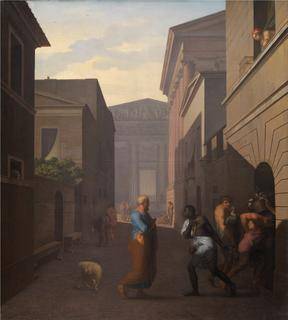
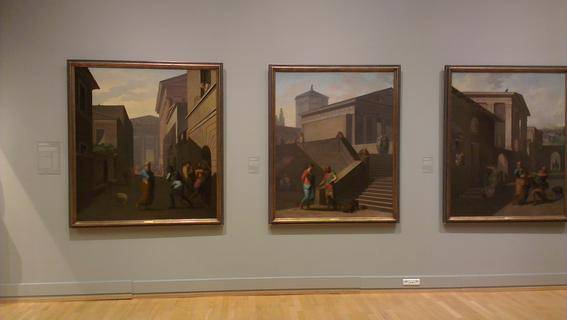
In Simo and his former slave Sosia symbolic linkages are made by Abildgaard with ancient enslavement and modern day slavery and anti-slavery. The online catalogue states "in the painter's version of the complicated dramatic intrigues, they begin when the central character, Simo, asks his black chef Sosia to pretend that he is hastening the marriage of Simo's son. The scene in the foreground links Terence and Abildgaard through a sequence of allusions: Terence was a slave who had been given his freedom, and in the picture Abildgaard based the black chef's appearance on a medal that he himself designed on the occasion of the Danish ban on slavery. In the play the chef is in fact also a liberated slave, and the playwright was from Africa himself."
These pieces of artwork highlight some of the various ways in which Black people have been depicted in European visual culture, from biblical allegory, to black servants during the period of enslavement and imperialism, to interpretations of ancient literature fusing imagery of contemporary Danish slavery and anti-slavery with ancient slavery. Overall, the Gallery includes some unique pieces, is expertly-curated and displayed. However, some of the text within the gallery could benefit from further expansion to reveal and give context to some of the histories of people of African heritage on display, perhaps in the form of a gallery trail or pamphlet. In the time I had I was only able to explore the whole of the first display, European Art 1300-1800, and some sections of the second, Danish and Nordic Art 1750-1900; further exploration of the other rooms would undoubtedly yield more artwork on this theme.
References
Allison Blakely. Blacks in the Dutch World: The Evolution of Racial Imagery in a Modern Society, Indiana University Press, 1993.
Bernhard Ridderbos, 'Objects and Questions' in Van Veen, Henk, Anne Van Buren, and Bernhard Ridderbos, eds. Early Netherlandish Paintings: Rediscovery, Reception and Research. Amsterdam: Amsterdam University Press, 2005.
Joseph Leo Koerner, 'The Epiphany of the Black Magus Circa 1500' in Bindman, David, Henry L. Gates, and Karen C. C. Dalton. eds. The Image of the Black in Western Art: Volume III, Part 1, Belknap, 2010.
Beth Fowkes Tobin, Picturing Imperial Power: Colonial Subjects in Eighteenth Century British Painting, Duke University Press, 1999.
 Close
Close


